Pop Culture
10 Times Art Infiltrated Pop Culture in 2021, From Beeple’s ‘Tonight Show’ Appearance to Damien Hirst’s Drake Cover Art
Plus, Christopher Walken destroyed a Banksy and every celebrity got into NFTs.
![Artist Damien Hirst [L] with Drake [R]. Photo: Theo Skudra. Artist Damien Hirst [L] with Drake [R]. Photo: Theo Skudra.](https://news.artnet.com/app/news-upload/2021/12/242068565_2907631349566654_8751471707361815151_n-1024x1024.jpeg)
Plus, Christopher Walken destroyed a Banksy and every celebrity got into NFTs.
![Artist Damien Hirst [L] with Drake [R]. Photo: Theo Skudra. Artist Damien Hirst [L] with Drake [R]. Photo: Theo Skudra.](https://news.artnet.com/app/news-upload/2021/12/242068565_2907631349566654_8751471707361815151_n-1024x1024.jpeg)
Taylor Dafoe

Stop me if you’ve heard this one before: It’s been a weird year.
That was true in the art world, too, where prices soared despite an economic crisis, immersive experiences drew crowds during a global pandemic, and something known as “non-fungible tokens” became the most coveted artworks in the world. A wild ride it all turned out to be—and it wasn’t just industry insiders who were paying attention along the way. Popular culture seemed more art-world curious than ever before in 2021.
The examples are many: T.V. mined art references for nuggets of social commentary, pop stars made music videos in museums; companies tried to leverage artist partnerships into cultural cache, and celebrities became experts in crypto art overnight.
Below, we’ve assembled the most notable moments of art infiltrating pop culture this year, each graded on a carefully calibrated scale of cultural relevance. Buckle up.
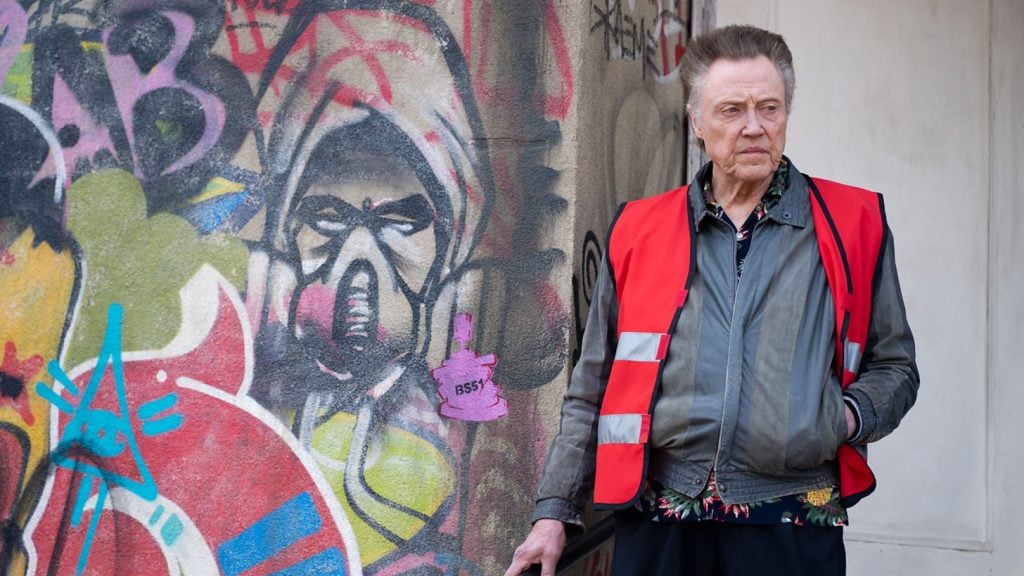
Christopher Walken on the BBC limited series The Outlaws. Courtesy of the BBC.
What: Walken took a paint roller to one of the anonymous street artist’s signature stenciled rats in the final episode of the BBC limited series The Outlaws, in which he plays a small-time career criminal tasked with community service. As it turns out, the work was a genuine Banksy that the artist had agreed to produce for the show—on the condition that it be destroyed.
When: November 2021
Cultural Impact Score: 3. The stunt made headlines in international media the week it happened, but since the show can’t be viewed outside the U.K., it had minimal staying power.
If you liked this, you’ll love…: Episode 11 in the most recent season of Ted Lasso. In it, a central character named Sam is being toured through a museum when he’s introduced to a balding, bumbling white dude in a shabby suit. A few seconds later, Sam learns the name of his new acquaintance: “That was Banksy,” he’s told.

A still with Omar Sy, who stars in the new Netflix series Lupin. Photo: Emmanuel Guimier/Netflix.
What: Banksy wasn’t the only art figure to make an appearance on the boob tube this year. It seemed like every other major new show this year featured an art world easter egg or two: Gagosian curator Antwaun Sargent showed up in the first episode of the Gossip Girl reboot, Greene Naftali gallery served as the site of a funeral in the new Sex and the City spinoff, and artist Rashid Johnson turned one of his “Anxious Men” paintings into a necklace for prestige T.V.’s own anxious man, Succession’s Kendall Roy. Meanwhile, the French thriller Lupin, about an expert thief who steals Marie Antoinette’s prized jewels from the Louvre, seemed like a near constant presence in Netflix’s top 10 rankings in January.
When: Throughout the year.
Cultural Impact Score: 7. In the above examples, the nods to the art world were clever, if ultimately minor. Still, these were major shows that everyone with a Twitter account seemed to watch.
If you liked this, you’ll love…: Season two of Emily In Paris, probably. A year ago, the show singlehandedly turned the “immersive” artist experience into an overnight sensation when it featured an illuminated Van Gogh exhibition. It also gave famed auctioneer Simon de Pury his biggest on-screen glow-up since the “If I Had a Hammer” music video. What will new episodes bring? They’re out now.
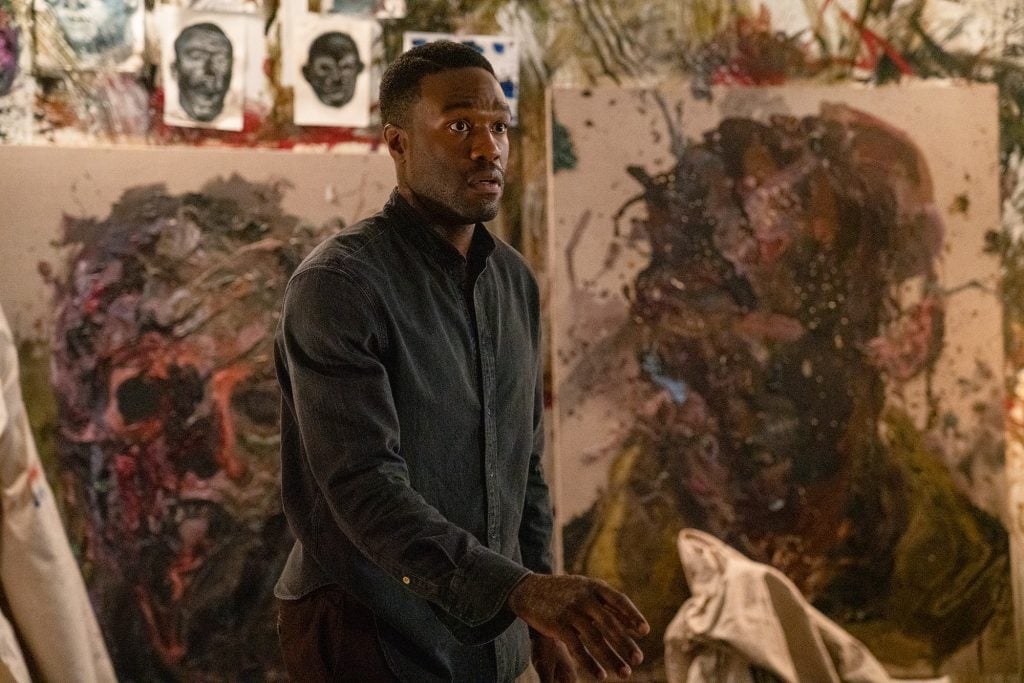
A still from Candyman (2021). © Parrish Lewis/Universal Pictures and MGM Pictures.
What: It wasn’t just the small screen that turned to the art world this year. A number of major films did as well, including Red Notice, an action romp about wanted art thieves that turned out to be Netflix’s most-watched product ever, Candyman, the newest example in a recent string of Hollywood horror flicks to use an art world setting as a prepackaged metaphor for moral corruption.
When: Throughout the year.
Cultural Impact Score: 4. Red Notice—according to Netflix’s mysterious math—was huge, but the art component in it wasn’t. And though Candyman had a lot to say—and used its art world setting to say it—the audience for horror movies is limited.
If you liked this, you’ll love…: The Electrical Life of Louis Wain, this year’s biopic about the eponymous painter of cats, starring Benedict Cumberbatch.
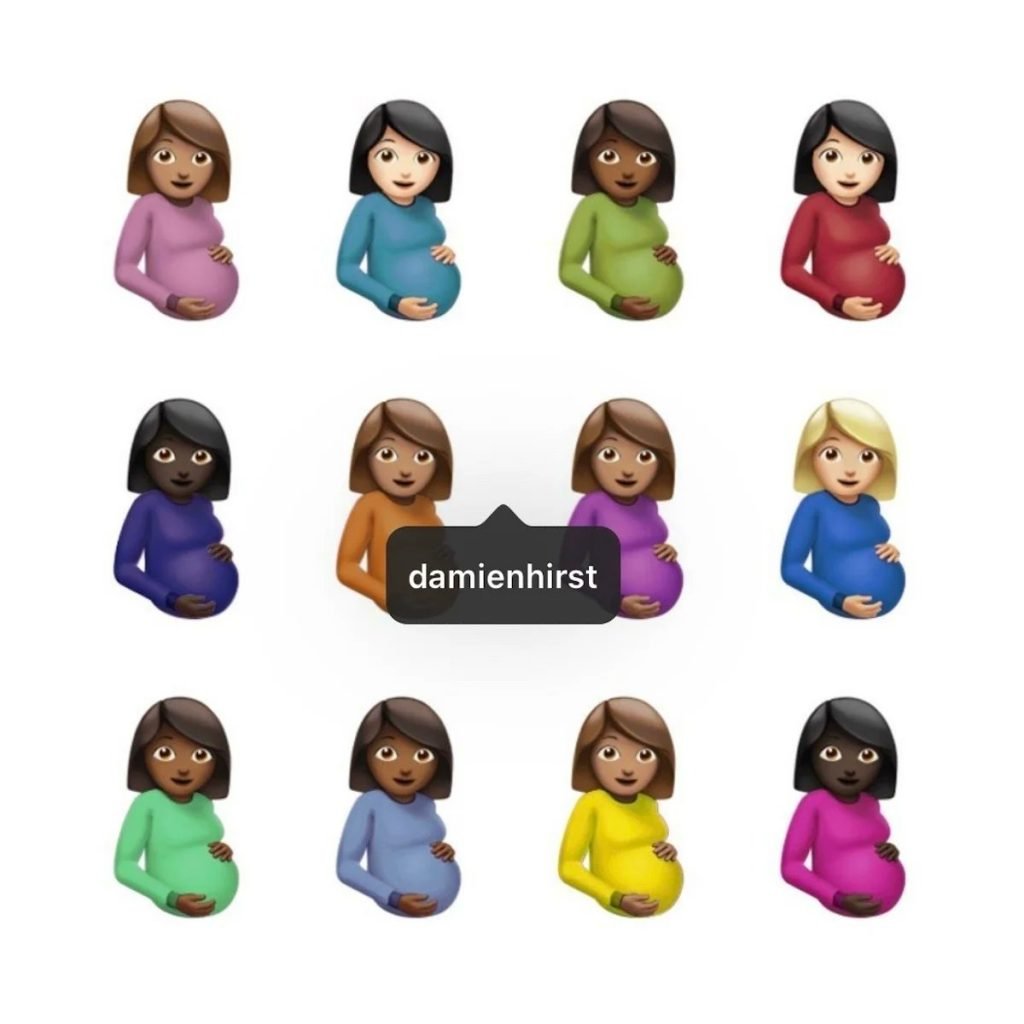
Drake’s Instagram post revealing the Damien Hirst-designed cover art for his new album, Certified Lover Boy.
What: Upon announcing the due date for his long-awaited new album, Certified Lover Boy, in August, Drake promptly sent the internet into a tizzy with a preview of the record’s bizarre cover art: an image of a dozen pregnant women emojis set against a white backdrop. A bigger surprise still was the fact that Damien Hirst designed the thing—like one of his signature dot paintings conceived (? ) with an iPhone. Drake and Hirst are pretty chummy, it turns out.
When: August 2021
Cultural Impact Score: Solid 8. Roughly half of Drake’s album made the Hot 100 list, even if its reviews were mostly middling, and Hirst’s reputation as an enfant terrible-turned-annoying-uncle didn’t change one bit. But the album artwork morphed into a mega-meme online, and it was genuinely fun for about a week.
If you liked this, you’ll love…: “Expensive Pain,” the new album from Rapper Meek Mill, for which Nina Chanel Abney was tapped to make the cover art.
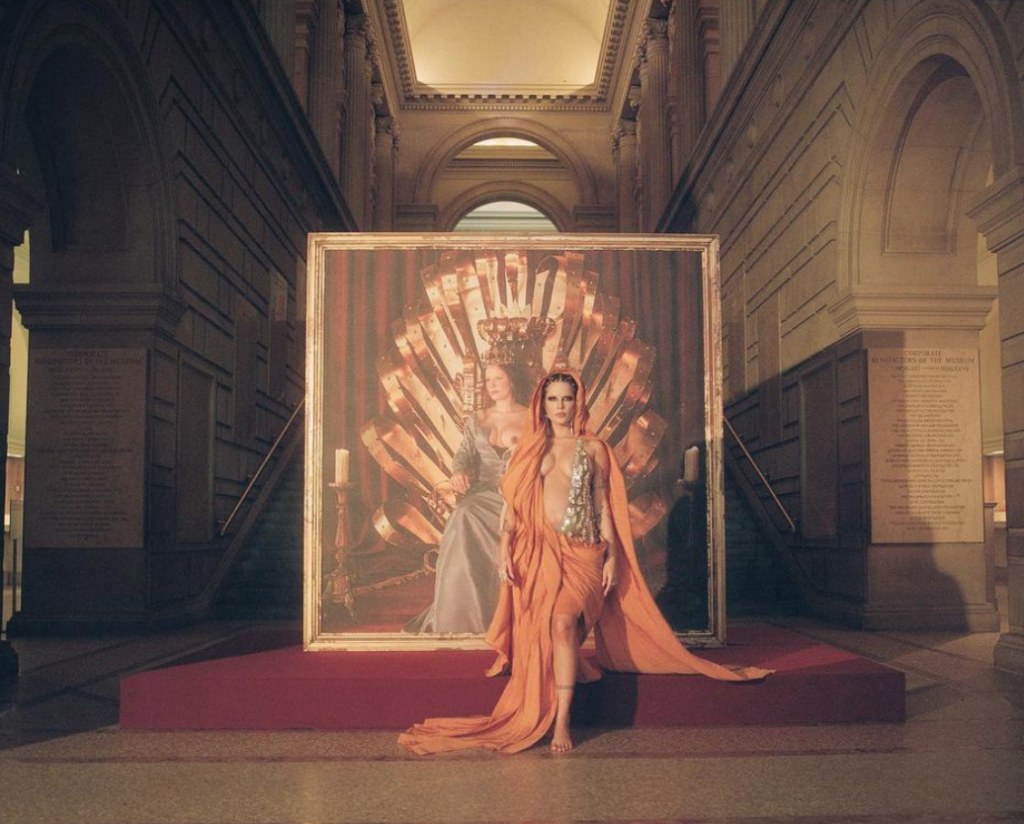
Halsey at the base of the Met main stairs with the album art of “If I Can’t Have Love, I Want Power.” Courtesy of the artist’s Instagram.
What: Drake wasn’t the only pop star with a surprising album art reveal this year. To unveil the cover of her own record, Halsey filmed a 13-minute-long video of herself pregnant and strolling around the empty halls of the Metropolitan Museum of Art’s European galleries, stopping to reflect upon various paintings of the Virgin Mary. The musician’s silent tour ends in front of a large photograph of herself seated atop an ornate throne, a breast bared and a baby on her knee—a nod to Jean Fouquet’s The Virgin and Child Surrounded by Angels and the artwork for her fourth album, If I Can’t Have Love, I Want Power.
“It was very important to me that the cover art conveyed the sentiment of my journey over the past few months. The dichotomy of the Madonna and the Whore,” she wrote on social media at the time, referencing her pregnancy.
When: July 2021.
Cultural Impact Score: Let’s say 4. Any points the video earned for its ambition were lost due its lack of nuance, and I’m willing to bet the singer’s exposed body parts drew more chatter online than the Duccio di Buoninsegna cameo.
If you liked this, you’ll love…: The music video for FKA Twigs’s song “Don’t Judge Me,” shot in the Turbine Hall at the Tate Modern. The video, released in January, features Kara Walker’s Fons Americanus, an epic fountain conceived as an allegory of the British slave trade.
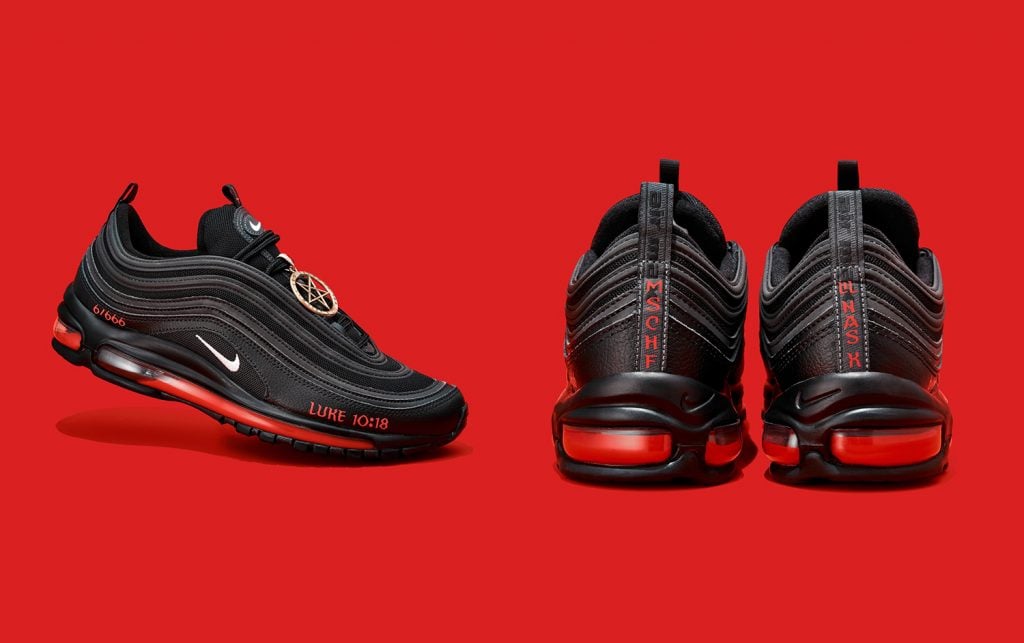
MSCHF’s “Satan Shoes,” created in collaboration with Little Nas X. Courtesy of MSCHF.
What: Early in the year, the irreverent art collective MSCHF dropped its most controversial project to date: “Satan Shoes,” a series of 666 pairs of Nike Air Maxes with drops of real human blood mainlined into the soles of each sneaker. (They were a spiritual sequel to the group’s 2019 effort, “Jesus Shoes”—a series of kicks injected with holy water from the River Jordan.) Released on the eve of Passover and in conjunction with the music video for Lil Nas X’s new song “Montero (Call Me By Your Name)”—a three-minute-long biblical fever dream in which the musician gives a lap dance to the devil—the shoes sold out in less than a minute. However, they weren’t popular with everyone. The project angered many, including Christians, conservative politicians—and, most notably, Nike, which sued the collective for trademark infringement. The two parties ended up settling out of court and MSCHF recalled its “Satan Shoes.”
When: March 2021.
Cultural Impact Score: 6 seems appropriate, and not just because of its association with the number of the beast. The legal dispute with Nike made headlines around the world, but neither MSCHF nor Lil Nas X—both modern masters in the internet attention economy—could have asked for better publicity. “Montero (Call Me By Your Name)” has been viewed over 400 million times on Youtube.
If you liked this, you’ll love…: MSCHF’s other projects this year, particularly Museum of Forgeries, in which the collective purchased an early sketch by Warhol, created 999 exact replicas, and then mixed all the artworks altogether and sold them for $250 a pop.
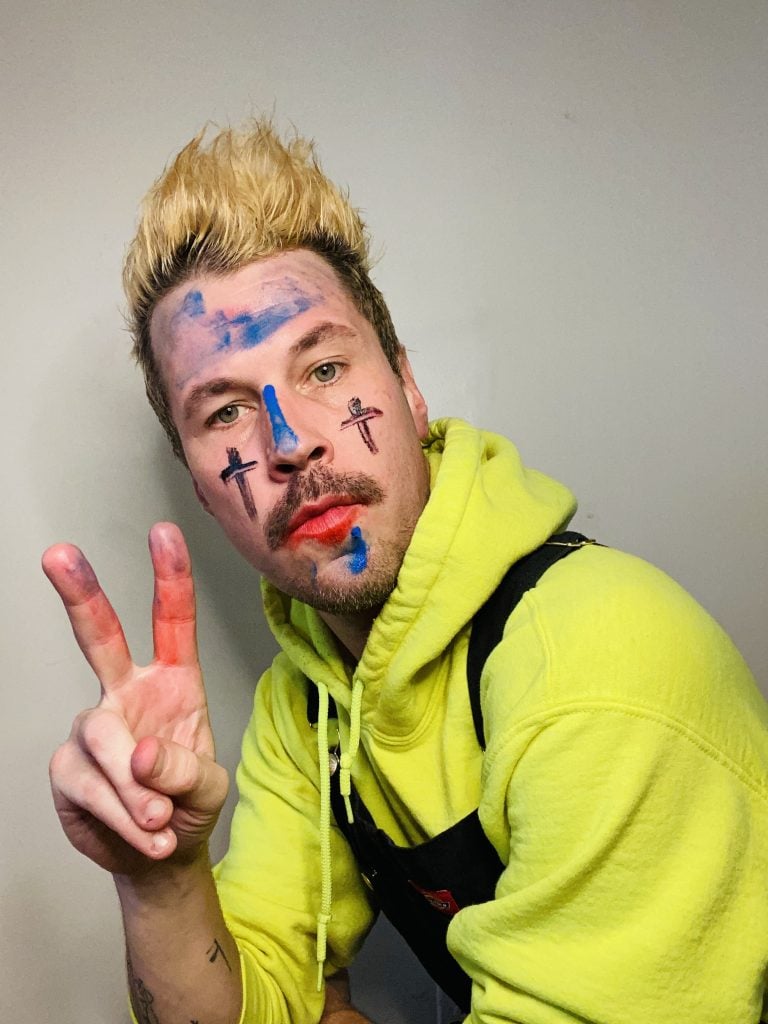
Brian Whiteley in character as Justin Bieber ahead of his show at “Gablowsian Gallery.” Photo courtesy of Brian Whiteley.
What: This fall, a press release went out advertising a new series of paintings made by Justin Bieber, each priced at $100,000. The announcement was clearly a gag—the gallerist hosting the show was called Harry Gablowsian—but apparently that wasn’t legible to the hundreds of Beliebers who RSVP’d for the opening. They, presumably, were not happy to find out the show was a quasi-conceptual ruse by Brooklyn artist Brian Whiteley, who was pretending to be the pop star. Nor was Bieber himself, whose lawyers subsequently sent a cease-and-desist letter to Whitely. “You can tell why celebrities turn into artists—all of a sudden you can make a buttload of money,” the artist said of his project, which he eventually re-titled “Justin Bieber Is Suing Me.”
When: November 2021.
Cultural Impact Score: 1. Whiteley’s funny flimflam didn’t make much of a splash, and if he ended up selling any paintings, he did so only for a couple of thousand each rather than six figures.
If you liked this, you’ll love…: That the man who was photographed as a baby for Nirvana’s Nevermind album cover decided to sue the band after it declined to participate in his art show. He swam after a dollar bill 30 years ago, and now he’s attempting to do something similar in court.
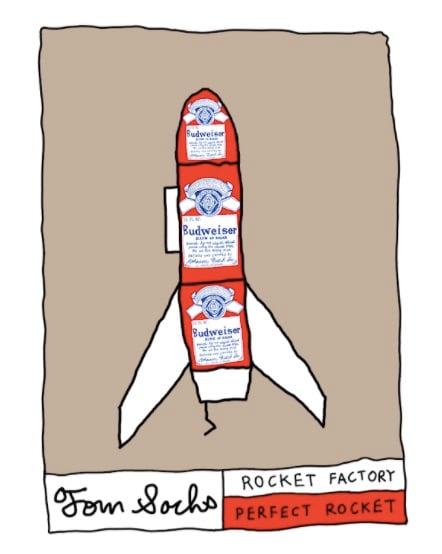
Screenshot of Tom Sachs, Life of the Party from the “Rocket Factory” NFT collection.
What: This summer, multinational beer conglomerate AB InBev tried to capitalize on the NFT trend by purchasing a $25,000 crypto-artwork by Tom Sachs for its Twitter profile. The company’s plan backfired, though, as users online noticed that Sachs’s design, a rocket, looked an awful lot like a penis. Soon, Budweiser’s newly acquired OpenSea wallet at Beer.eth was flooded with unsolicited NFT artworks that looked like crude dick pics.
When: August 2021
Cultural Impact Score: 5. I don’t know if this story amounted to much more than an inside joke for crypto-art communities and a cautionary tale for clever corporate marketing departments, but it was pretty funny. And was there a more 2021 story this year?
If you liked this, you’ll love…: “Love” might be a strong word, but days before Budweiser’s debacle, Visa bought a $150,000 crypto punk for its corporate collection. While still a marketing stunt, Visa’s move at least demonstrated some business tact: “To help our clients and partners participate, we need a firsthand understanding of the infrastructure requirements for a global brand to purchase, store, and leverage an NFT,” the company’s head of crypto said at the time.
What: This fall, after selling his hybridized NFT/IRL sculpture HUMAN ONE at Christie’s for $29 million, crypto-artist Beeple made his first late-night appearance on The Tonight Show Starring Jimmy Fallon. His hair was messy.
When: November 2021.
Cultural Impact Score: 9. The interview wasn’t particularly notable, but the moment was: If we needed any more evidence that crypto art had settled into the mainstream, this T.V. appearance, where Mike Winkelmann, a man who 12 months ago was known to almost no one, shared a stage with Will Ferrell, was it.
If you liked this, you’ll love…: This breakdown of the images in Beeple’s Everydays, which sold for a shocking $69 million at Christies in March, by Artnet News critic Ben Davis.

A photo NFT influencer Cozomo de’ Medici tweeted of themselves with singer Jason Derulo.
What: Jay-Z, Quentin Tarantino, David Lynch, Emily Ratajkowski, Paris Hilton: The list of notable names who entered into the NFT game this year is legitimately too long to write out, and more entrants are joining every day. At first, the celebrity affirmations were thrilling, testaments each to the wild kinetic energy the world of crypto art was able to whip up in the culture, seemingly overnight. Now, seeing news that a famous person is minting an NFT feels closer to seeing that person in a car commercial: less an endorsement of a new cool thing and more an exercise in selling out. Even Melania Trump has an NFT platform now.
When: Throughout the year.
Cultural Impact Score: 10.
If you liked this, you’ll love…: The rumor that the online crypto-art savant Cozomo de’ Medici is actually Snoop Dogg. The story of how the beloved rapper became implicated is full of mystery, intrigue, and Jason Derulo cameos.